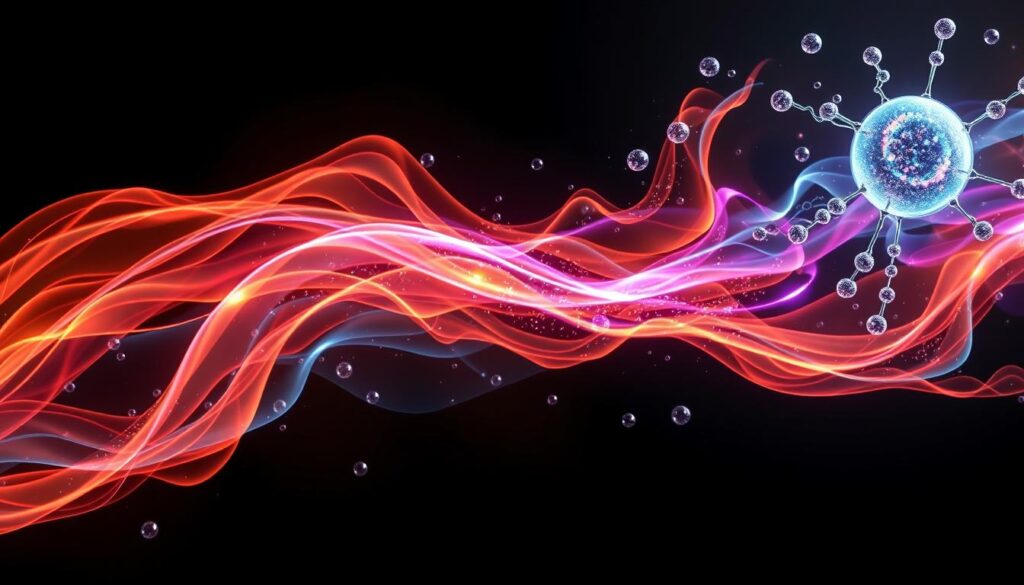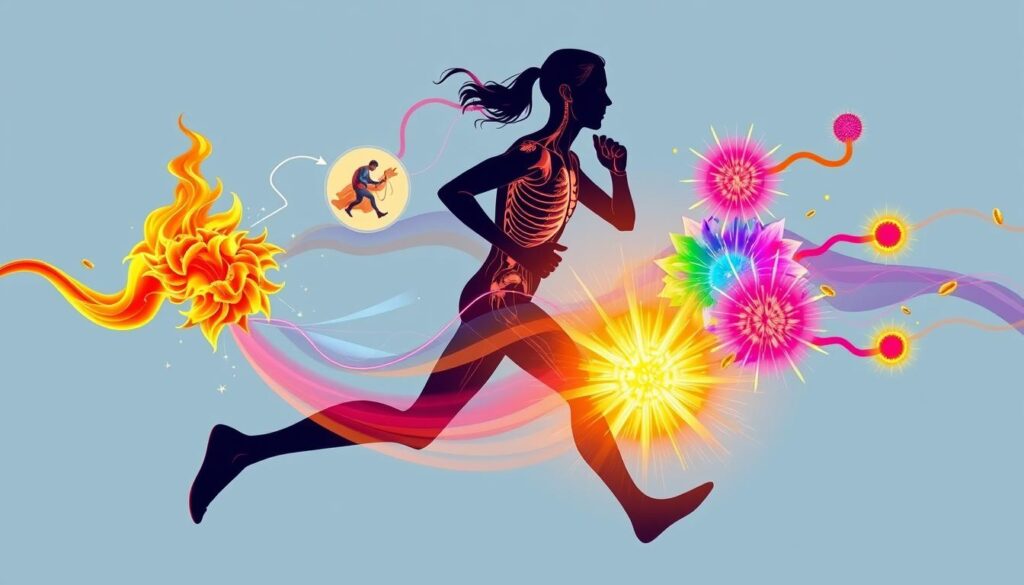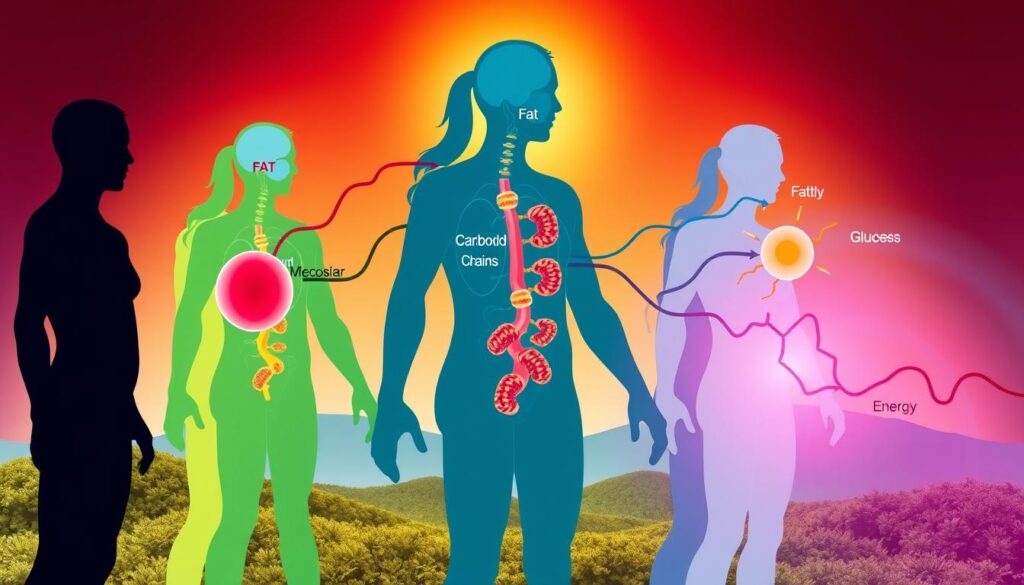Do you want to lose weight or stay healthy? Knowing how your body uses fuel is key. Food is your body’s main fuel, with carbs and fat being the main players. Learning about your body’s energy systems can help you burn fat better and reach your fitness goals.
Key Takeaways
- Carbs and fat are the main energy sources for your body. Carbs give quick energy, while fat provides longer-lasting power.
- Your body has three energy systems: the phosphagen, glycolytic, and oxidative systems. They work together to make ATP, your body’s energy.
- The amount of carbs and fat burned changes with exercise intensity. Hard workouts use more carbs, while easy ones burn more fat.
- Knowing how carbs and fat help your body make energy can improve your workouts and diet for fat loss.
- To stay healthy, eat right and stay active. This helps you keep a good weight.
The Science Behind Energy Systems in Your Body
To know how your body uses fat or carbs, you need to understand energy systems. These systems are the phosphagen, glycolytic, and oxidative systems. They work together to power your body’s activities.
Understanding ATP and Energy Production
At the heart of energy production is a molecule called adenosine triphosphate (ATP). ATP is the main energy source in your cells. Your body must keep making ATP to power your muscles and organs. The three energy systems make ATP in different ways, each with its own strengths and limits.
Three Main Energy Systems Explained
- Phosphagen System: This system gives quick energy for short, intense activities like sprinting or weightlifting.
- Glycolytic System: This system uses carbs for fuel. It has fast and slow parts to make ATP. It’s key for exercises that last a few minutes.
- Oxidative System: Also called the aerobic system, it’s the main energy source for low to moderate activities. It uses fat as fuel, making it vital for long exercises.
How Your Body Uses Different Energy Sources
When you exercise, your body picks the right energy system based on the activity’s intensity and length. At rest, the oxidative system is most active, making about 70% of ATP from fat and 30% from carbs. As you get more active, the body uses more carbs and the glycolytic system becomes more important. Knowing how these systems work helps you optimize workouts for burning fat.
| Energy System | Fuel Source | Duration | Intensity |
|---|---|---|---|
| Phosphagen | Creatine phosphate | Up to 10 seconds | High |
| Glycolytic | Carbohydrates | Up to a few minutes | Moderate |
| Oxidative | Fats and carbohydrates | Longer durations | Low to moderate |
“Understanding the different energy systems in your body is the key to unlocking your full potential for fat burning and overall fitness.”
Burn Fat vs Carbs: What’s the Difference?
Choosing to burn fat or carbs affects your body’s energy. Knowing how they work helps you improve your workouts.
Carbs give you quick energy. They help you start your workouts strong. Fat is slower to use but lasts longer.
At first, your body uses carbs for energy. But as you keep moving, it starts to burn fat. The type of exercise you do affects this switch.
- About 41 million search results are returned when searching for information on burning carbohydrates and fat.
- Studies have shown that a single carbohydrate can be oxidized at around 1 gram/minute.
- The rate of carbohydrate oxidation can increase by 20-50% when ingesting different types of carbohydrates that utilize different intestinal transports for absorption.
- The total carbohydrate intake for fructose/glucose combination can reach 1.75 grams/minute.
Knowing about fat burning and carb burning helps you train better. It leads to better energy utilization and performance.
“The crossover point where carbohydrates become the primary fuel source is typically between intensities higher than 65% of one’s VO2 Max. Maximal fat oxidation occurs between 45-65% of one’s VO2 Max.”
Understanding Carbohydrates as Fuel
Carbohydrates are key for fueling your body. They are stored in muscles and liver as glycogen. This energy is ready to use when you exercise.
Blood Glucose and Glycogen Storage
Your body turns carbs into glucose. This glucose is in your blood and gives energy to your cells. Any extra glucose turns into glycogen for later use.
How Your Body Processes Carbs During Exercise
During exercise, your muscles use glycogen and blood glucose for energy. This is why carbs are best for quick, intense workouts. They turn into ATP fast, which is energy for your cells.
When glycogen runs out, your body uses more fat for energy. This is why mixing different types of exercise is good. It helps use carbs and fat well.
| Energy Source | Calories per Gram | Utilization During Aerobic Exercise | Utilization During Anaerobic Exercise |
|---|---|---|---|
| Carbohydrates | 4 | 35% | 60% |
| Fats | 9 | 60% | 35% |
Knowing how carbs help your body’s energy is key. It helps you eat right and work out better. This supports your fitness goals.
The Role of Fat in Energy Production
Fat is very important for your body’s energy. It has 9 calories per gram, more than carbs’ 4 calories. Your body turns fat into fatty acids for energy.
Fat burning is slower but more efficient than carbs. Your body uses fat more during low to moderate exercise and rest. It’s key for longer or harder workouts, helping with recovery and ATP levels.
| Fuel Source | Calories per Gram | Energy Efficiency | Best for |
|---|---|---|---|
| Carbohydrates | 4 calories | Rapid but less efficient | High-intensity exercise |
| Fat | 9 calories | Slower but more efficient | Low-intensity, endurance exercise |
Using fat for energy can change the game. It helps with energy efficiency and fat oxidation. Knowing how fat works can improve your workouts and diet.

“Fat is the main fuel source for long-duration, low- to moderate-intensity exercises.”
Exercise Intensity and Energy Source Selection
The intensity of your workout affects how your body uses energy. It decides whether you burn fat or carbs. The type of exercise you do matters a lot.
High-Intensity vs Low-Intensity Impact
High-intensity workouts use carbs as the main fuel. This is because carbs can be broken down fast. They give quick energy for intense exercises.
But, low-intensity exercises use more fat for energy. At rest, fat is the main energy source, making up 85% of it. Carbs make up 15%.
As you start exercising, carbs and fat work together. During moderate exercise, they both make 50% of ATP. But, as you get more intense, carbs become the main fuel.
The Truth About the “Fat-Burning Zone”
Cardio machines show a “fat-burning zone.” It’s a low-intensity area where more calories come from fat. But, it’s not the only way to lose fat.
High-intensity workouts burn more calories. This can lead to more fat loss. The goal is to burn more calories than you eat, not just use fat.
Fitter people use fat better for energy. But, even fit people use carbs more during intense exercise. Sprinting and intervals use carbs more too.
“The key to weight loss is creating a calorie deficit, regardless of the energy source.”
Metabolic Adaptations During Different Activities
Your body is amazing and always changes to meet your needs. When you exercise, how it uses energy changes a lot. This depends on the kind and how hard you work out.
When you do cardio exercises, your body first uses carbs for energy. But as you keep going, it starts to use more fat oxidation. This lets you keep going longer by using fat for energy.
Resistance training uses different energy sources. It might not burn as many calories during the workout. But, it helps your body burn more calories when you’re not moving by building muscle.
How well you use energy during exercise also changes over time. People who exercise a lot can use more fat and less carbs. This is because their bodies get better at using different energy sources.
| Exercise Type | Primary Energy System | Fat Oxidation | Metabolic Adaptation |
|---|---|---|---|
| Cardio | Aerobic | Increases over time | Enhanced fat utilization |
| Resistance Training | Phosphagen, Glycolysis | Relatively lower | Increased resting metabolic rate |
Knowing how your body changes during different exercises can help you get better results. It’s key for losing fat or improving your overall health and fitness.

“Chronic aerobic exercise training enhances lipid metabolism and can lead to decreased cardiac risk factors.”
Caloric Deficit: The Key to Fat Loss
Weight loss starts with a calorie deficit. This means you burn more calories than you eat. The body then uses fat for energy.
The 3,500-calorie rule is well-known. It says burning 3,500 more calories than you eat equals losing one pound of fat.
Understanding the 3,500-Calorie Rule
The 3,500-calorie rule is a basic guide. It shows how calorie deficit and fat loss are linked. It says losing 3,500 calories leads to losing one pound of fat.
Creating an Effective Energy Deficit
For lasting weight loss, aim for a 500-calorie daily deficit. You can do this by eating less and moving more. Both cardio and strength training help.
Here are some ways to cut calories:
- Drink water instead of soda or juice
- Choose air-popped popcorn over chips
- Eat smaller portions of high-calorie foods
- Do regular activities like walking or cycling
It’s important to be balanced. Cutting too many calories or exercising too much is bad. It can lead to not getting enough nutrients and feeling tired.
“Cutting calories, maintaining a minimum level, and ensuring a sustainable calorie deficit are key to successful weight loss.”
Learning about calorie deficit and using smart strategies can help you lose fat. Remember, losing weight takes time and effort. Stay consistent and patient.
Optimizing Your Workout for Fat Burning
To burn fat well, mix up your workouts. Try high-intensity interval training (HIIT) and longer, steady cardio. This combo boosts your metabolism and burns calories.
HIIT is great for losing weight and burning fat. It’s short, intense bursts followed by rest. This keeps your metabolism high and burns calories even after you stop. Do HIIT workouts one or two times a week to recover and avoid injuries.
Longer, steady cardio like walking, jogging, or cycling is also key. It burns more calories and helps use fat for energy. The American College of Sports Medicine says to do at least 150 minutes of moderate exercise or 75 minutes of vigorous exercise weekly. Add strength training for the best results.
By mixing workout optimization, fat loss exercises, HIIT, and endurance training, you can burn fat effectively. This helps you reach your weight loss goals.

